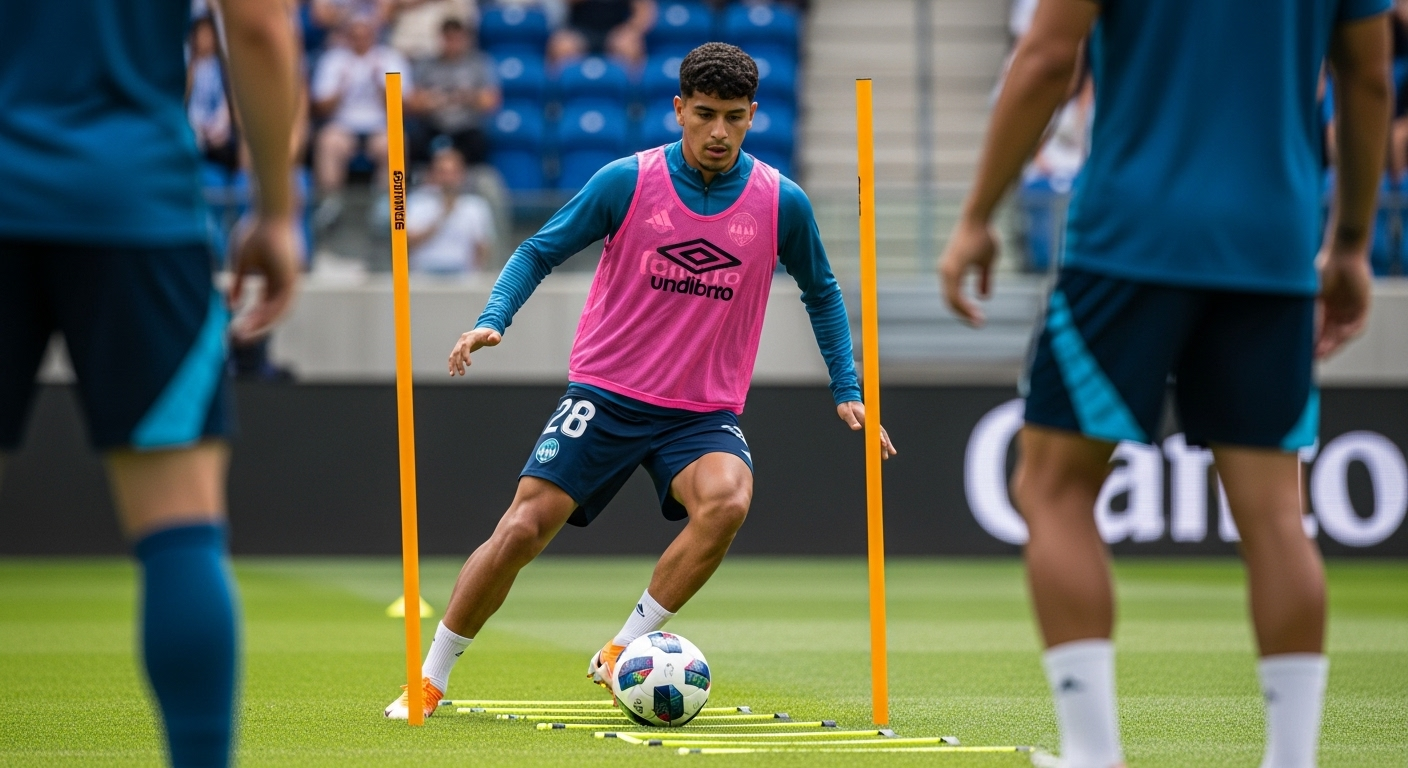The Art of Tactical Periodization in Team Sports
In the dynamic world of team sports, success often hinges on more than just individual talent. Tactical periodization, a revolutionary approach to training and performance optimization, has been quietly reshaping how elite teams prepare for competition. This method, blending physical conditioning with strategic game understanding, is transforming the landscape of team sports performance.

The Origins and Evolution of Tactical Periodization
The concept of tactical periodization emerged in the late 1990s, primarily through the work of Portuguese football coach Vítor Frade. Frade, dissatisfied with traditional training methods that often treated physical conditioning and tactical development as separate entities, sought to create a more integrated approach that better reflected the demands of modern team sports.
Frade’s ideas were initially met with skepticism but gradually gained acceptance as teams implementing his methods began to see remarkable improvements in both performance and results. The philosophy behind tactical periodization is rooted in the belief that all aspects of a player’s development should be contextualized within the tactical framework of their sport and position.
As the approach evolved, it began to incorporate elements from various disciplines, including sports science, psychology, and biomechanics. This multidisciplinary foundation allowed tactical periodization to address the complex interplay between physical demands, decision-making processes, and team dynamics that characterize team sports.
The Core Principles of Tactical Periodization
At its heart, tactical periodization is guided by several key principles that distinguish it from traditional training methodologies:
-
Specificity: All training activities are designed to replicate the specific demands of competition, ensuring that players develop skills and fitness in a context that directly translates to game situations.
-
Integrated Approach: Physical, technical, and tactical training are not treated as separate components but are seamlessly integrated into each session, mirroring the multifaceted nature of team sports.
-
Cyclical Planning: Training is organized in cycles that correspond to the competitive calendar, allowing for periodic peaks in performance aligned with crucial matches or tournaments.
-
Tactical Prioritization: The team’s tactical model serves as the foundation for all training activities, ensuring that physical and technical development always serves the overarching game strategy.
-
Individual within Collective: While emphasizing team tactics, the approach also recognizes the importance of individual player development within the context of the team’s tactical framework.
These principles work in concert to create a training environment that closely mimics the complexities and demands of actual competition, preparing players not just physically, but mentally and tactically for the challenges they will face on the field or court.
Implementing Tactical Periodization in Practice
The practical application of tactical periodization requires a fundamental shift in how training sessions are conceived and executed. Rather than separating physical conditioning, skill work, and tactical drills into distinct segments, coaches design integrated sessions that simultaneously address multiple aspects of player and team development.
A typical training week in a tactical periodization framework might be structured as follows:
-
Acquisition Day: Focus on introducing or refining specific tactical concepts, with physical work tailored to support these objectives.
-
Strength Day: Emphasis on developing the physical attributes necessary for executing the team’s tactical plan, integrated with tactical decision-making exercises.
-
Speed Day: High-intensity work designed to improve players’ ability to execute tactical actions at game speed, often incorporating opposition and decision-making elements.
-
Pre-Competition Day: Fine-tuning of tactical plans for the upcoming match, with physical work tailored to ensure players are fresh and prepared.
Throughout this cycle, coaches carefully modulate training intensity and complexity to ensure optimal adaptation and recovery, always keeping the team’s tactical model at the forefront of planning and execution.
The Science Behind Tactical Periodization
The effectiveness of tactical periodization is supported by a growing body of scientific research. Studies have shown that this integrated approach leads to improvements in various performance markers, including:
-
Enhanced decision-making skills under pressure
-
Improved physical conditioning specific to game demands
-
Better team coordination and synchronization
-
Reduced injury rates due to more sport-specific training
Researchers have noted that the contextual learning environment created by tactical periodization allows players to develop a deeper understanding of the game, leading to more intelligent and adaptable performances on the field.
Neurological studies have also provided insights into why this approach is effective. The integration of physical and cognitive challenges in training has been shown to enhance neural plasticity, potentially accelerating skill acquisition and tactical understanding.
Challenges and Considerations in Adopting Tactical Periodization
While the benefits of tactical periodization are significant, implementing this approach is not without challenges. Coaches and sports scientists must navigate several key considerations:
-
Complexity of Implementation: The integrated nature of tactical periodization requires a high level of expertise and careful planning to execute effectively.
-
Player Adaptation: Athletes accustomed to traditional training methods may initially struggle with the increased cognitive demands of this approach.
-
Monitoring and Assessment: Evaluating player progress and team development requires sophisticated tracking tools and analytics to capture the multifaceted nature of performance improvements.
-
Cultural Shift: Adopting tactical periodization often necessitates a cultural change within a team or organization, requiring buy-in from players, coaching staff, and management.
-
Long-term Perspective: The full benefits of this approach may take time to manifest, requiring patience and commitment from all stakeholders.
Despite these challenges, many top-tier teams have found that the long-term benefits of tactical periodization far outweigh the initial hurdles in implementation.
Case Studies: Success Stories in Tactical Periodization
Several high-profile teams across various sports have successfully implemented tactical periodization, with notable improvements in performance and results:
-
FC Porto under José Mourinho: One of the earliest and most famous adopters of tactical periodization, Porto’s success in the early 2000s, including winning the UEFA Champions League, brought widespread attention to this methodology.
-
German National Football Team: The German Football Association’s adoption of principles aligned with tactical periodization is credited as a key factor in their 2014 FIFA World Cup victory.
-
San Antonio Spurs (NBA): While not explicitly labeled as tactical periodization, the Spurs’ integrated approach to player development and team strategy shares many similarities with this methodology, contributing to their sustained success over multiple seasons.
These examples demonstrate the versatility of tactical periodization across different sports and competitive levels, showcasing its potential to drive long-term success when properly implemented.
The Future of Tactical Periodization
As sports science continues to advance, tactical periodization is likely to evolve and incorporate new insights and technologies. Several trends are shaping the future of this methodology:
-
Artificial Intelligence and Machine Learning: AI-driven analysis of player and team performance data is enabling more precise and personalized training prescriptions within the tactical periodization framework.
-
Virtual Reality Training: VR technology is being explored as a tool to enhance tactical understanding and decision-making skills without the physical demands of on-field training.
-
Biometric Monitoring: Advanced wearable technology is providing real-time data on player physiology and movement, allowing for more precise modulation of training loads and recovery strategies.
-
Psychological Integration: Greater emphasis is being placed on incorporating mental skills training and psychological preparation into the tactical periodization model.
-
Cross-Sport Application: The principles of tactical periodization are being adapted and applied to a wider range of team sports, from ice hockey to rugby, as coaches seek to optimize performance across diverse competitive environments.
As these innovations are integrated into the tactical periodization framework, the approach is likely to become even more sophisticated and effective in developing high-performing teams.
Ethical Considerations and Fair Play
While tactical periodization offers significant competitive advantages, it also raises important ethical considerations within the realm of sports. As teams seek to optimize every aspect of performance, there is a risk of pushing athletes beyond healthy limits or creating disparities between well-resourced and less-resourced teams.
Sports governing bodies and coaching associations are increasingly addressing these concerns by:
-
Developing guidelines for safe and ethical implementation of advanced training methodologies
-
Promoting knowledge sharing to ensure equitable access to cutting-edge training approaches
-
Emphasizing the importance of player welfare and long-term development over short-term gains
These efforts aim to ensure that the benefits of tactical periodization and similar advanced methodologies can be realized without compromising the integrity of sport or the well-being of athletes.
Conclusion: The Transformative Potential of Tactical Periodization
Tactical periodization represents a paradigm shift in how teams approach training and performance optimization in sports. By integrating physical, technical, and tactical development into a cohesive system, this methodology offers a more holistic and effective approach to preparing athletes for the complex demands of modern team sports.
As more teams across various sports adopt and adapt the principles of tactical periodization, we are likely to see continued evolution in training methodologies, tactical sophistication, and overall performance standards. The success stories from top-tier teams have demonstrated the transformative potential of this approach when implemented with expertise and commitment.
However, the true value of tactical periodization extends beyond just winning matches or championships. It offers a framework for developing more intelligent, adaptable, and well-rounded athletes who are better equipped to handle the physical and mental challenges of their sport. This comprehensive development not only enhances on-field performance but also contributes to the long-term health and career longevity of athletes.
As sports science continues to advance, tactical periodization will undoubtedly evolve, incorporating new technologies and insights to further refine its effectiveness. The challenge for coaches, sports scientists, and athletes will be to harness these advancements while staying true to the core principles that make tactical periodization such a powerful tool for performance enhancement.
Ultimately, the art of tactical periodization lies in its ability to seamlessly blend the physical, technical, and mental aspects of sport into a unified approach that mirrors the complex, dynamic nature of competition. As this methodology continues to gain traction and evolve, it promises to reshape not just how teams train, but how we understand and approach excellence in team sports.





